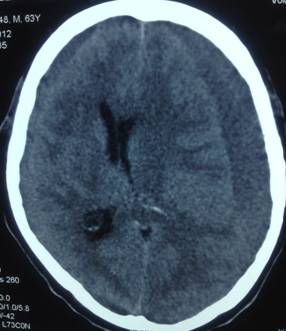C A S E O F T H E M O N T H

CHRONIC SUBDURAL HEMATOMA
A 63 year old gentleman presented with a one month history of confusion and right-sided weakness. This started a few days after he slipped and fell in the bathroom, hitting his head. His wife noted that he would give incorrect replies and mix up dates and times. He had problems with his memory and could not recognize certain people and objects. He became sleepy all the time and spoke less and less. He developed right-sided weakness and the family brought him to the nearest ER, fearing that he had a stroke.
Upon arrival, the patient was drowsy and unable to follow commands. Stat CT scan showed that he had a chronic subdural hematoma in the left side of his head.
A chronic subdural hematoma is a blood clot located in the subdural space, the space between the brain and the dura (the outer covering of the brain). “Chronic” means that the blood has been there for a long time, at least 2 weeks. If the hematoma is thin and the patient is awake and alert, surgery may not be needed since the hematoma may resolve on its own over time. However, if the hematoma is thick (greater than 1 cm thick), and the patient is not awake, then emergency surgery may be needed to drain the blood and relieve the pressure inside the skull.
The patient underwent burrhole craniectomy and evacuation of the hematoma. A few hours after surgery, he became awake and alert, and his clinical condition continued to improve over the next 48 hours. He was able to speak coherently and follow commands, and his right side became strong again. He was discharged well a few days after surgery |